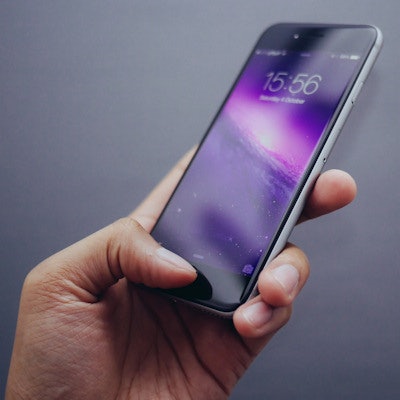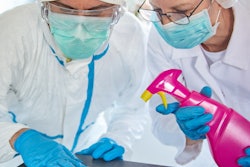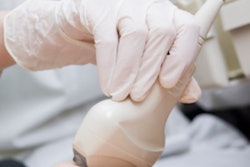
Almost half of the radiographers at two Irish hospitals don't clean their phones, a new study has found. That's a problem because phones can harbor pathogens associated with nosocomial infections. The solution is multimodal awareness programs, the authors say.


The researchers displayed this poster in an effort to cut down on poor phone hygiene. Image courtesy of Ciara Crofton and Shane Foley, PhD.
The study included radiographers at two university hospitals, with one hospital acting as the experiment and the other acting as the control. The researchers swabbed radiographers' mobile phones to test their cleanliness and surveyed participants to determine their current practices and awareness level around mobile phone hygiene. In the experiment hospital, the researchers launched a poster campaign to highlight the issue, and they found it resulted in better phone hygiene but not better hand hygiene (Radiography, 1 September 2017).
People lack awareness of mobile phones' association with hospital-acquired infections -- poor phone disinfection and improper hand hygiene can spread germs, according to Ciara Crofton, a radiographer at University Hospital Galway in the Republic of Ireland, and her co-author Shane Foley, PhD, the radiography program coordinator at University College Dublin. And lack of awareness results in inadequate infection-control practices.
"Radiographers are usually very careful and vigilant regarding good infection-control measures, yet the mobile phone seems to have been forgotten," Foley wrote in an email to AuntMinnieEurope.com. "Mobile phone use in the clinical environment will only continue to rise, so we must reduce the infection risks associated with it. Being aware of your hygiene habits associated with phone use is imperative."
Hotbeds of pathogens
Hospital-acquired infections result in 16 million extra days of hospital stay, with an associated cost of 11 billion euros, according to the World Health Organization (WHO). They also reduce patient quality of life and can prove fatal, the study authors noted.
 Shane Foley, PhD, radiography program coordinator, University College Dublin.
Shane Foley, PhD, radiography program coordinator, University College Dublin.The average rate of pathogen contamination is 9% to 25% with pathogens such as methicillin-resistant Staphylococcus aureus (MRSA; 1% to 10%) and the Acinetobacter species (1% to 12%) residing on the phone's surface, according to a study by Richard Brady and colleagues in the Journal of Hospital Infection (April 2009, Vol. 71:4, pp. 295-300).
"Considering the fact that phones have been shown to harbor nosocomial pathogens such as MRSA, healthcare workers should treat their phone as if it's a contaminated object," Foley wrote. "We need to remember that the combination of frequent hand contact and the inherent heat associated with these phones makes our pockets an ideal breeding ground for bacteria."
The good news is that strong evidence shows up to 50% of hospital-acquired infections are avoidable, primarily by practicing proper hygiene, according to the WHO. Proper hygiene means washing the hands after phone use and regular phone disinfection using 70% isopropyl alcohol.
How well-known and well-practiced are these hygienic measures? That's precisely what Crofton and Foley sought to discover. Furthermore, would adding a poster about the topic to raise awareness make a difference?
Phones come under scrutiny
The researchers approached 36 radiographers without prior warning and had them complete a survey on a tablet while their phone was swabbed. Phone cleanliness was determined by adenosine triphosphate (ATP) readings. In the experiment hospital, the researchers displayed a poster for four weeks. After one month, the researchers swabbed the same radiographers' phones at the experiment hospital and the control hospital.
They found 97% of participants used their phone at least several times per day, with 47% using it at least several times per hour. A moderate negative correlation between the age of the participant and the frequency of phone use indicated that younger participants were likely to use their phone more often. Two-thirds (66%) of participants did not clean their phone at least weekly, and 44% never cleaned their phone.
Those who cleaned their phones used dry cloth/tissue (11%) or a wet cloth/tissue (19%). No participants adequately performed hand hygiene following phone use (i.e., washing the hands with soap and water or alcohol gel for 15 seconds after phone use).
In terms of ATP measurements, Crofton and Foley found no significant difference in mean ATP readings between the hospitals before and after the campaign, but they did find nonstatistically significant numerical reductions in the mean ATP measurements before and after the intervention period in both hospitals. The control hospital had a greater reduction in the mean ATP count, but 79% of participants in the experiment hospital showed reductions in their individual ATP scores, with only 57% of those in the control showing reductions.
The lack of change in ATP scores can be explained because even weekly disinfection can cause high contamination levels to accumulate. Even if participants did begin phone disinfection, the ATP results may not show the effects, which was true in this case, according to the study authors.
Half of the radiographers more frequently disinfected their phones in the experiment hospital following the campaign. In addition, they disinfected their phones properly using alcohol – the percentage of radiographers who used the optimal method went from 13% before the campaign to 46% after the campaign.
In terms of hand hygiene, 53% of respondents in the experiment hospital improved their method compared with only 14% of those in the control. The majority of participants in the control didn't change, which reinforces the theory that without the poster campaign, it's unlikely for any changes to be made.
"An educational campaign can be useful for different levels of awareness," the authors wrote. "It can educate those who need a basic understanding while simultaneously reminding those with some knowledge to put it into action."
Putting knowledge into action is the authors' main focus right now, according to Foley.
"Our main interest at present is actually disseminating the results of the current study, as widely as possible so that we can raise awareness not just amongst radiographers, but all healthcare professionals," he wrote.
Possible future research could explore other methods of educating radiographers and healthcare professionals about mobile phone infection control.
"I think it is important to note that, while radiographers were focused upon, this study is very relevant to all healthcare professionals," Foley concluded.



















